By Elise Seyfried
Statistics indicate that a person who dies by suicide is most likely to be a white or Native American male, aged 55 to 75. Men are three times more likely than women to die by suicide. But statistics don’t tell a complete story. Deaths of despair occur with every age, gender and ethnicity.
Todd was 22, a recent college graduate working as a civil engineer, and a bright young man with a promising future. Yet he suffered from deep depression. On a Friday evening, Todd called his mother, Sherry, and said he was thinking of ending his life. Sherry got him to a hospital emergency room. Unfortunately, the medical personnel concluded that he was not a risk to himself, and he was sent home. Todd died by suicide on Sunday.
Heather was a loving mom of two. She sang in her congregation’s praise band and was very involved with church activities. But Heather had a history of self-harm as a teenager, and her mental health issues surfaced again. She attempted suicide four times in one year before losing her life to suicide. Heather told her family, “I just want this pain to stop.” She died at age 53.
Deb was a wife, a mother of three and a professor of public health. She taught Sunday school for many years and was much loved in the community. Unlike Heather, Deb gave no indication that she was contemplating suicide— she seemed excited about upcoming events. But Deb, too, suddenly passed away, at age 49.
Todd, Heather and Deb have left us, but their stories are not over. Their families have turned grief into positive action, participating in suicide prevention efforts on local and national levels.
Here’s some advice from their families:
- Let young people know to tell a caring adult if a friend confides that they are experiencing suicidal thoughts. There are resources and people to help.
- Educate yourself and others about suicide risk and prevention.
- Don’t be afraid to ask a person if they’re thinking of suicide—it won’t increase the chances of completion.
“As someone who lost a family member to suicide and now works in the mental health field, it’s evident to me that mental health is a part of human nature,” says Deb’s daughter, Tess. “Some people might just be better at hiding the bad, in fear of being judged.”
Deb’s husband, Mike, adds: “Don’t try to find answers; find peace. For those who want to support people who are grieving, you are not a reminder of loss, but a reminder of the love that person shared. There are no right words, so don’t try to find them. Just be there.”
For centuries, suicide was considered a grave sin. Those who died by suicide were condemned by the church. Nowadays churches stress that God loves the deceased person tremendously and welcomes them into heaven. Suicide is a desperate act, born of great mental anguish. We need to pay attention to each other and reach out if we see someone struggling. And hopefully, someday, suicides will stop, forever.
Elise Seyfried is the author of five books of humorous spiritual essays. Elise recently retired after 20 years as director of spiritual formation at Christ Lutheran Church in Oreland, Pennsylvania.
This article appeared in the May/June 2024 issue of Gather. To read more like it, subscribe to Gather.



Thank you for reminding me of the article. My father and my brother completed suicide about 20 years a part. I am part of PFLAG in my area for many reasons but partly because suicide rates are so high in the lgbtqia community. I speak and pay attention and I respond when needed. No more suicide on my watch.
I am very much interested in these messages. Just received an email from a friend who sent me the link